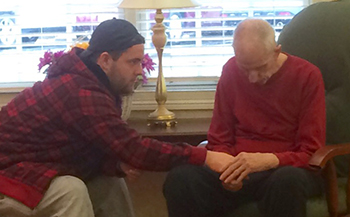Opening Minds through Art (OMA) for medical school and health sciences students

As our population ages, an increasing majority of physicians’ clients are older adults. Developing person-centered values and skills to communicate with older adults will benefit physicians of all specialties and their patients.
“Based on 10 years of operation at Miami University serving over 2,000 pairs of Miami students and elders with dementia, we are confident that OMA can improve medical students’ ability to connect and communicate with older adults living with dementia in person-centered ways,” shared Elizabeth “Like” Lokon, OMA’s founder and director. In this pilot project, involving ten universities, medical and health sciences students will go through online training followed by the opportunity to engage one-on-one with someone with dementia. The expected outcomes, based on previous evaluation studies, are increased dementia knowledge, increased comfort level in and positive regard toward older adults living with dementia.
When asked where OMA will be in ten years, Lokon responded, “I would like to see OMA being offered to students in medical schools and all health science professions across the nation so that health professionals can be more person-centered in their jobs. As a result, older adults, with and without dementia, can have better health care experiences and outcomes.”
A pilot project involving the following universities is already underway:
- Maryville University, Master of Occupational Therapy program
- Marian University College of Osteopathic Medicine
- Miami University, Department of Nursing and Department of Speech Pathology and Audiology
- Ohio University's Heritage College of Osteopathic Medicine
- Penn State College of Medicine
- Southern Illinois University School of Medicine
- The Ohio State University College of Medicine
- The University of New England College of Osteopathic Medicine
- The University of Toledo College of Medicine and Life Sciences
- University of Cincinnati College of Medicine and Department of Communication Sciences & Disorders

